Taxation Law Assignment: Analyzing Deductions, Credits, and GST Issues
VerifiedAdded on 2020/02/18
|18
|2485
|352
Homework Assignment
AI Summary
This taxation law assignment provides solutions to various tax-related issues. Question 1 focuses on determining allowable deductions under section 8-1 of the ITAA 1997, analyzing the deductibility of expenses related to moving machinery, revaluing assets for insurance, legal expenses in winding up a business, and legal expenses for business operations. Question 2 examines the input tax credit for advertising expenditure under the GST Act 1999, referencing relevant rulings and case law. The assignment applies relevant legislation and case law to analyze each scenario, providing detailed explanations and conclusions for each requirement and question. The solution offers a comprehensive understanding of tax principles and their practical application.
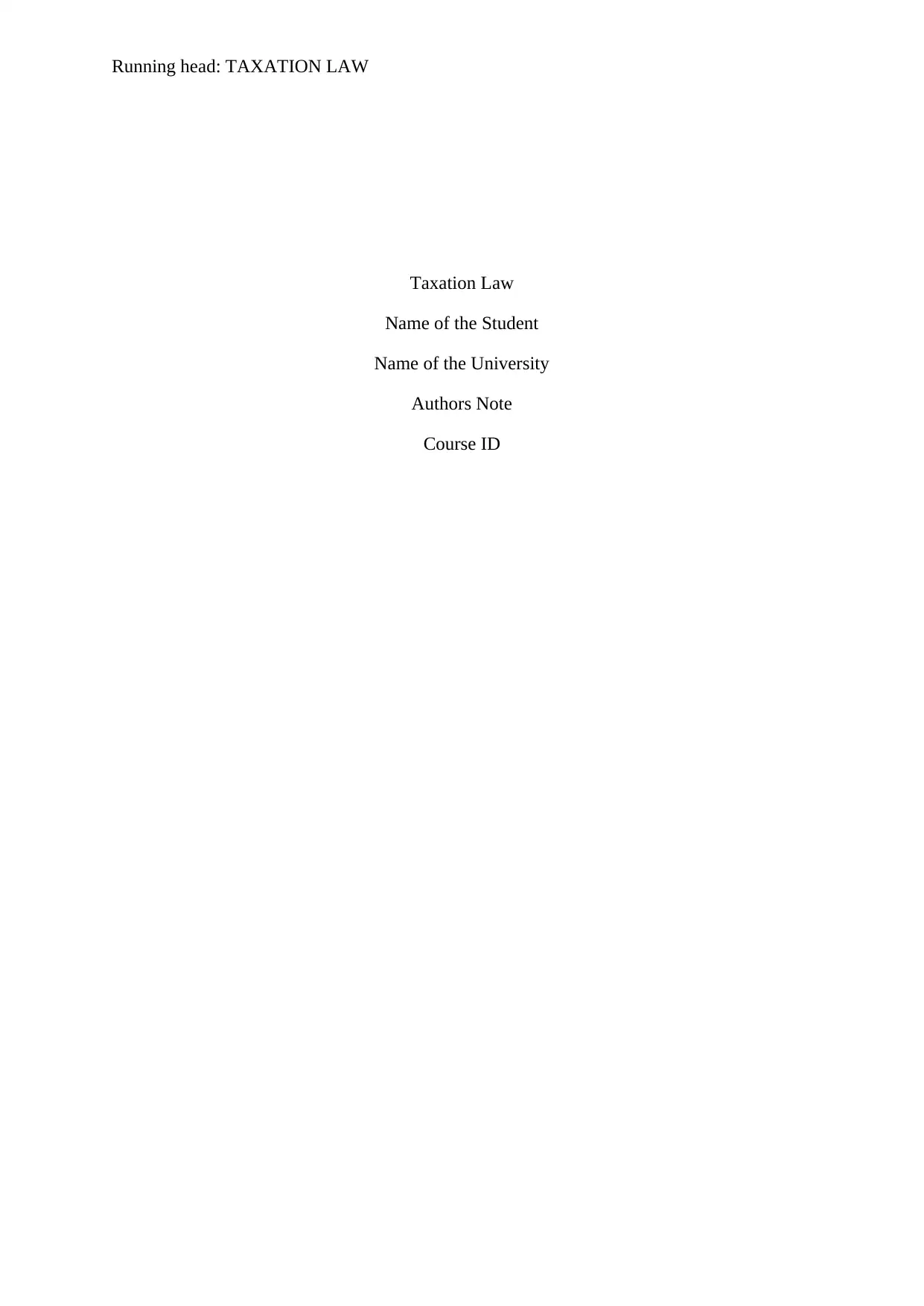
Running head: TAXATION LAW
Taxation Law
Name of the Student
Name of the University
Authors Note
Course ID
Taxation Law
Name of the Student
Name of the University
Authors Note
Course ID
Paraphrase This Document
Need a fresh take? Get an instant paraphrase of this document with our AI Paraphraser
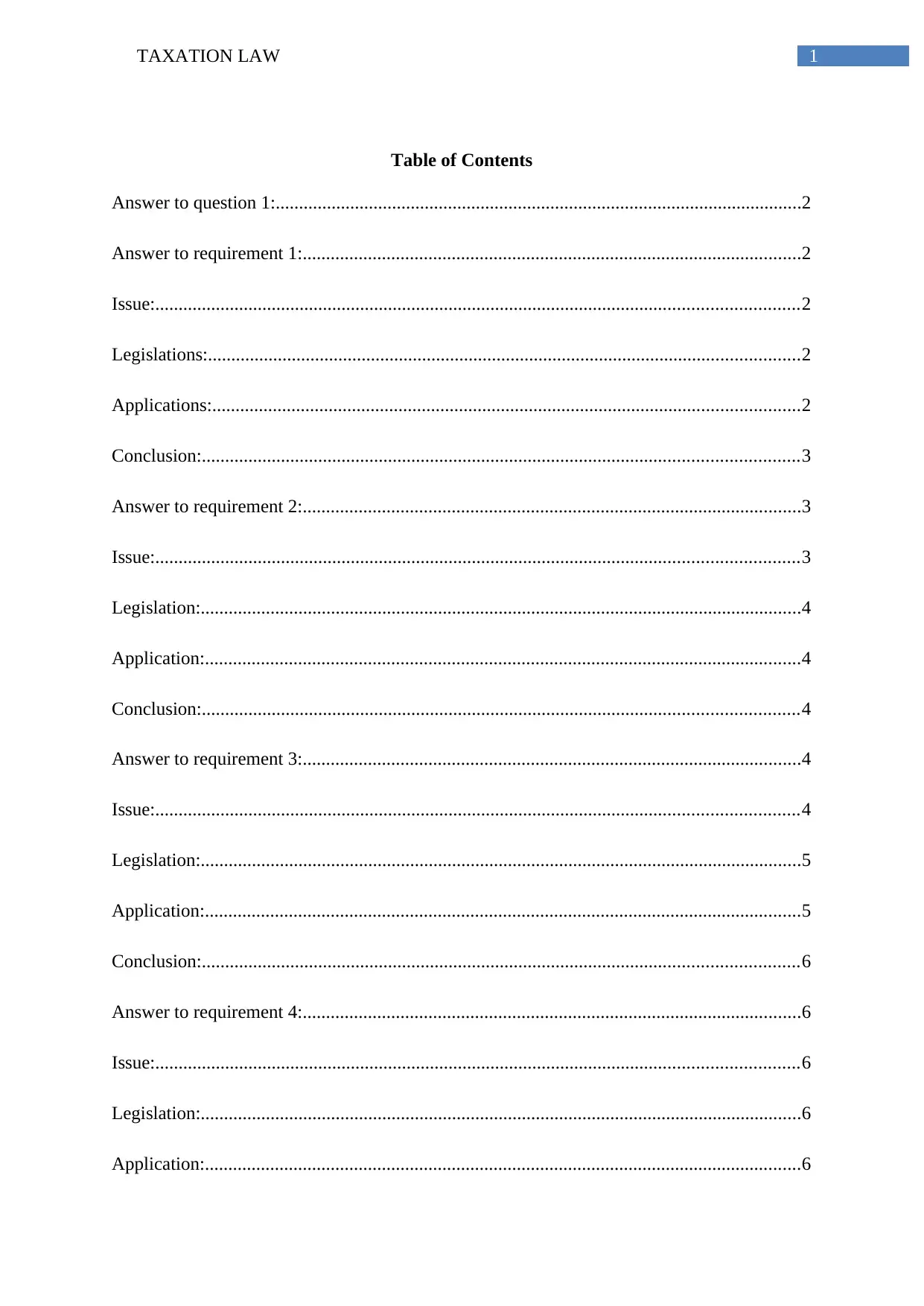
1TAXATION LAW
Table of Contents
Answer to question 1:.................................................................................................................2
Answer to requirement 1:...........................................................................................................2
Issue:..........................................................................................................................................2
Legislations:...............................................................................................................................2
Applications:..............................................................................................................................2
Conclusion:................................................................................................................................3
Answer to requirement 2:...........................................................................................................3
Issue:..........................................................................................................................................3
Legislation:.................................................................................................................................4
Application:................................................................................................................................4
Conclusion:................................................................................................................................4
Answer to requirement 3:...........................................................................................................4
Issue:..........................................................................................................................................4
Legislation:.................................................................................................................................5
Application:................................................................................................................................5
Conclusion:................................................................................................................................6
Answer to requirement 4:...........................................................................................................6
Issue:..........................................................................................................................................6
Legislation:.................................................................................................................................6
Application:................................................................................................................................6
Table of Contents
Answer to question 1:.................................................................................................................2
Answer to requirement 1:...........................................................................................................2
Issue:..........................................................................................................................................2
Legislations:...............................................................................................................................2
Applications:..............................................................................................................................2
Conclusion:................................................................................................................................3
Answer to requirement 2:...........................................................................................................3
Issue:..........................................................................................................................................3
Legislation:.................................................................................................................................4
Application:................................................................................................................................4
Conclusion:................................................................................................................................4
Answer to requirement 3:...........................................................................................................4
Issue:..........................................................................................................................................4
Legislation:.................................................................................................................................5
Application:................................................................................................................................5
Conclusion:................................................................................................................................6
Answer to requirement 4:...........................................................................................................6
Issue:..........................................................................................................................................6
Legislation:.................................................................................................................................6
Application:................................................................................................................................6
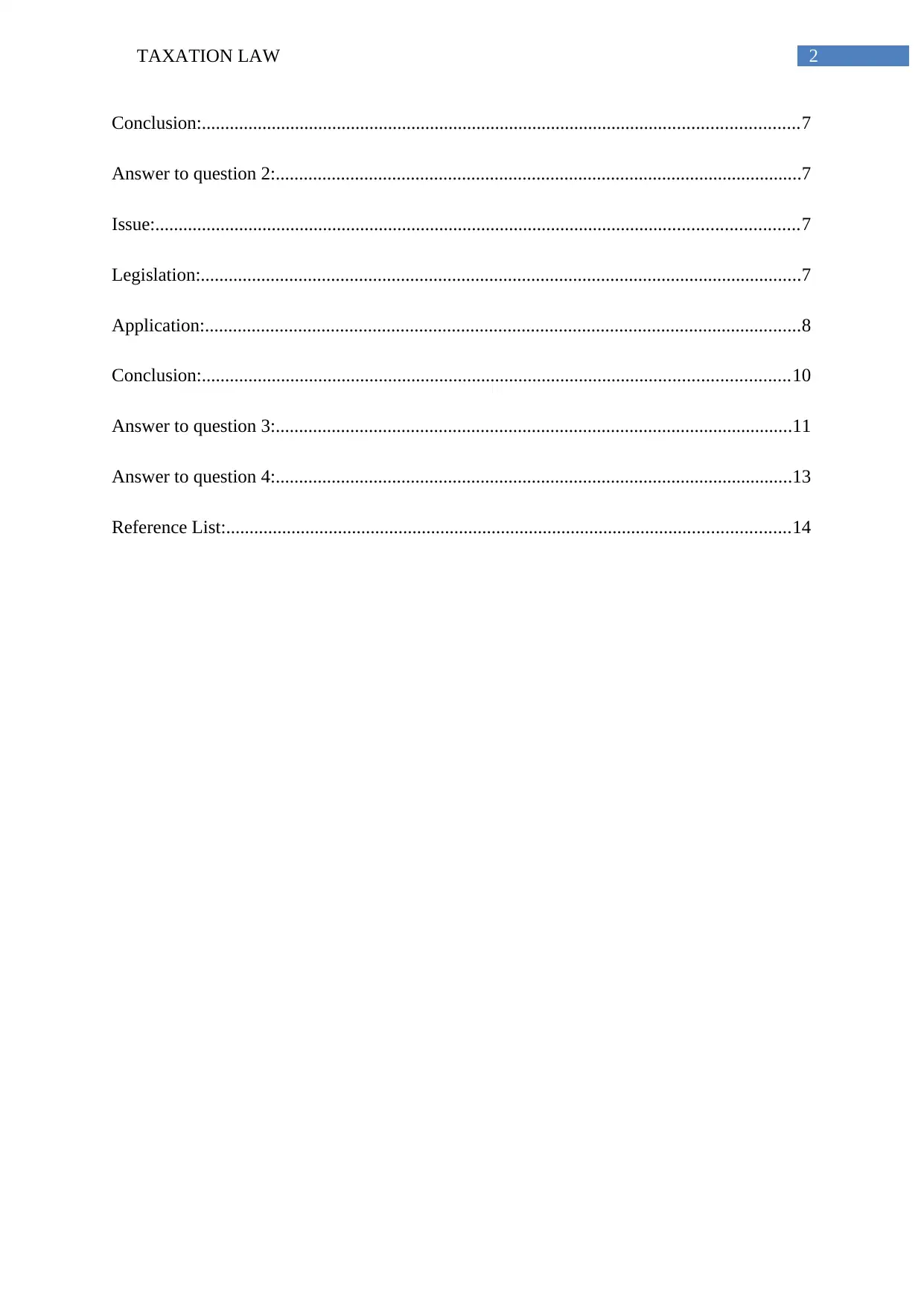
2TAXATION LAW
Conclusion:................................................................................................................................7
Answer to question 2:.................................................................................................................7
Issue:..........................................................................................................................................7
Legislation:.................................................................................................................................7
Application:................................................................................................................................8
Conclusion:..............................................................................................................................10
Answer to question 3:...............................................................................................................11
Answer to question 4:...............................................................................................................13
Reference List:.........................................................................................................................14
Conclusion:................................................................................................................................7
Answer to question 2:.................................................................................................................7
Issue:..........................................................................................................................................7
Legislation:.................................................................................................................................7
Application:................................................................................................................................8
Conclusion:..............................................................................................................................10
Answer to question 3:...............................................................................................................11
Answer to question 4:...............................................................................................................13
Reference List:.........................................................................................................................14
⊘ This is a preview!⊘
Do you want full access?
Subscribe today to unlock all pages.

Trusted by 1+ million students worldwide
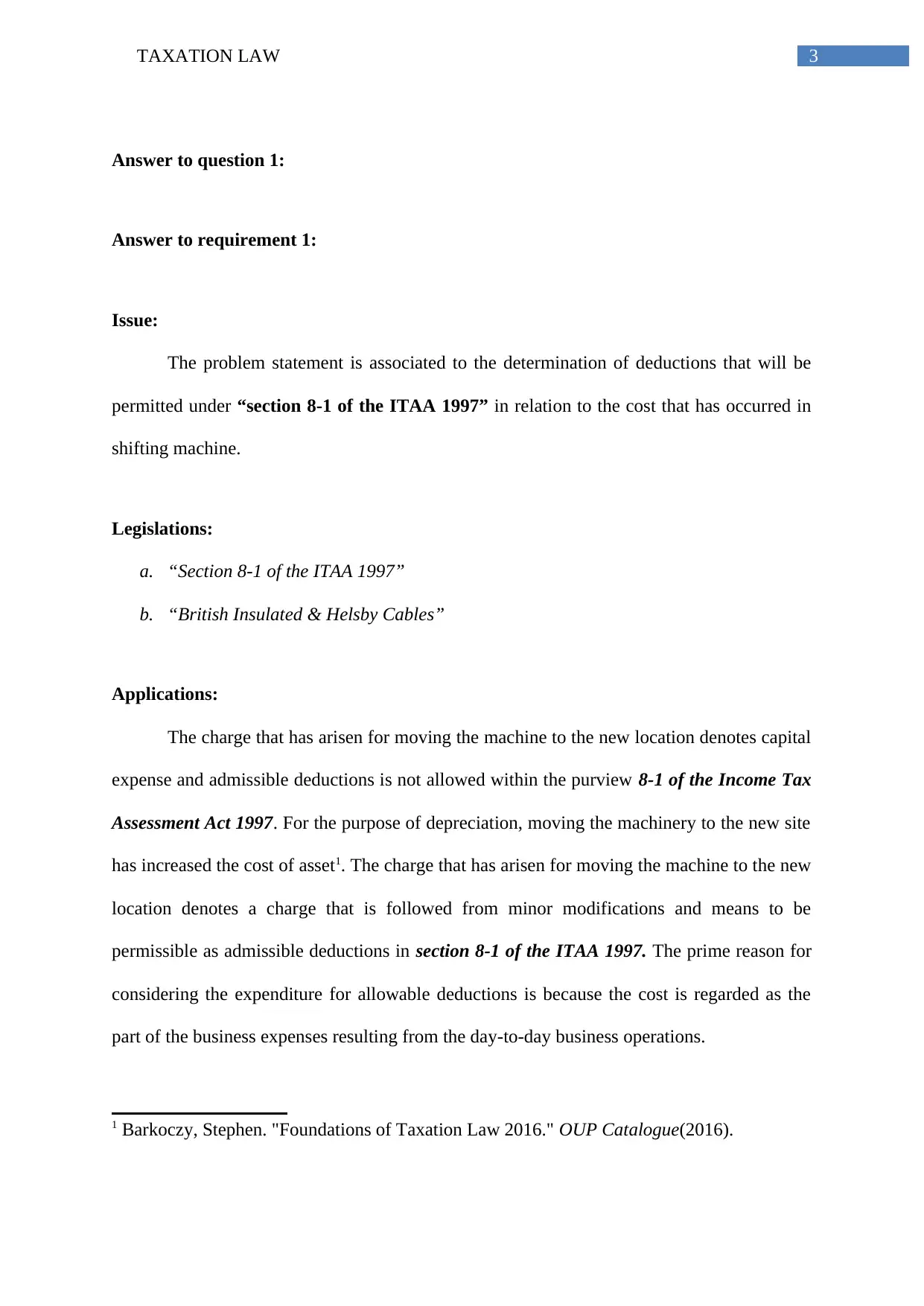
3TAXATION LAW
Answer to question 1:
Answer to requirement 1:
Issue:
The problem statement is associated to the determination of deductions that will be
permitted under “section 8-1 of the ITAA 1997” in relation to the cost that has occurred in
shifting machine.
Legislations:
a. “Section 8-1 of the ITAA 1997”
b. “British Insulated & Helsby Cables”
Applications:
The charge that has arisen for moving the machine to the new location denotes capital
expense and admissible deductions is not allowed within the purview 8-1 of the Income Tax
Assessment Act 1997. For the purpose of depreciation, moving the machinery to the new site
has increased the cost of asset1. The charge that has arisen for moving the machine to the new
location denotes a charge that is followed from minor modifications and means to be
permissible as admissible deductions in section 8-1 of the ITAA 1997. The prime reason for
considering the expenditure for allowable deductions is because the cost is regarded as the
part of the business expenses resulting from the day-to-day business operations.
1 Barkoczy, Stephen. "Foundations of Taxation Law 2016." OUP Catalogue(2016).
Answer to question 1:
Answer to requirement 1:
Issue:
The problem statement is associated to the determination of deductions that will be
permitted under “section 8-1 of the ITAA 1997” in relation to the cost that has occurred in
shifting machine.
Legislations:
a. “Section 8-1 of the ITAA 1997”
b. “British Insulated & Helsby Cables”
Applications:
The charge that has arisen for moving the machine to the new location denotes capital
expense and admissible deductions is not allowed within the purview 8-1 of the Income Tax
Assessment Act 1997. For the purpose of depreciation, moving the machinery to the new site
has increased the cost of asset1. The charge that has arisen for moving the machine to the new
location denotes a charge that is followed from minor modifications and means to be
permissible as admissible deductions in section 8-1 of the ITAA 1997. The prime reason for
considering the expenditure for allowable deductions is because the cost is regarded as the
part of the business expenses resulting from the day-to-day business operations.
1 Barkoczy, Stephen. "Foundations of Taxation Law 2016." OUP Catalogue(2016).
Paraphrase This Document
Need a fresh take? Get an instant paraphrase of this document with our AI Paraphraser
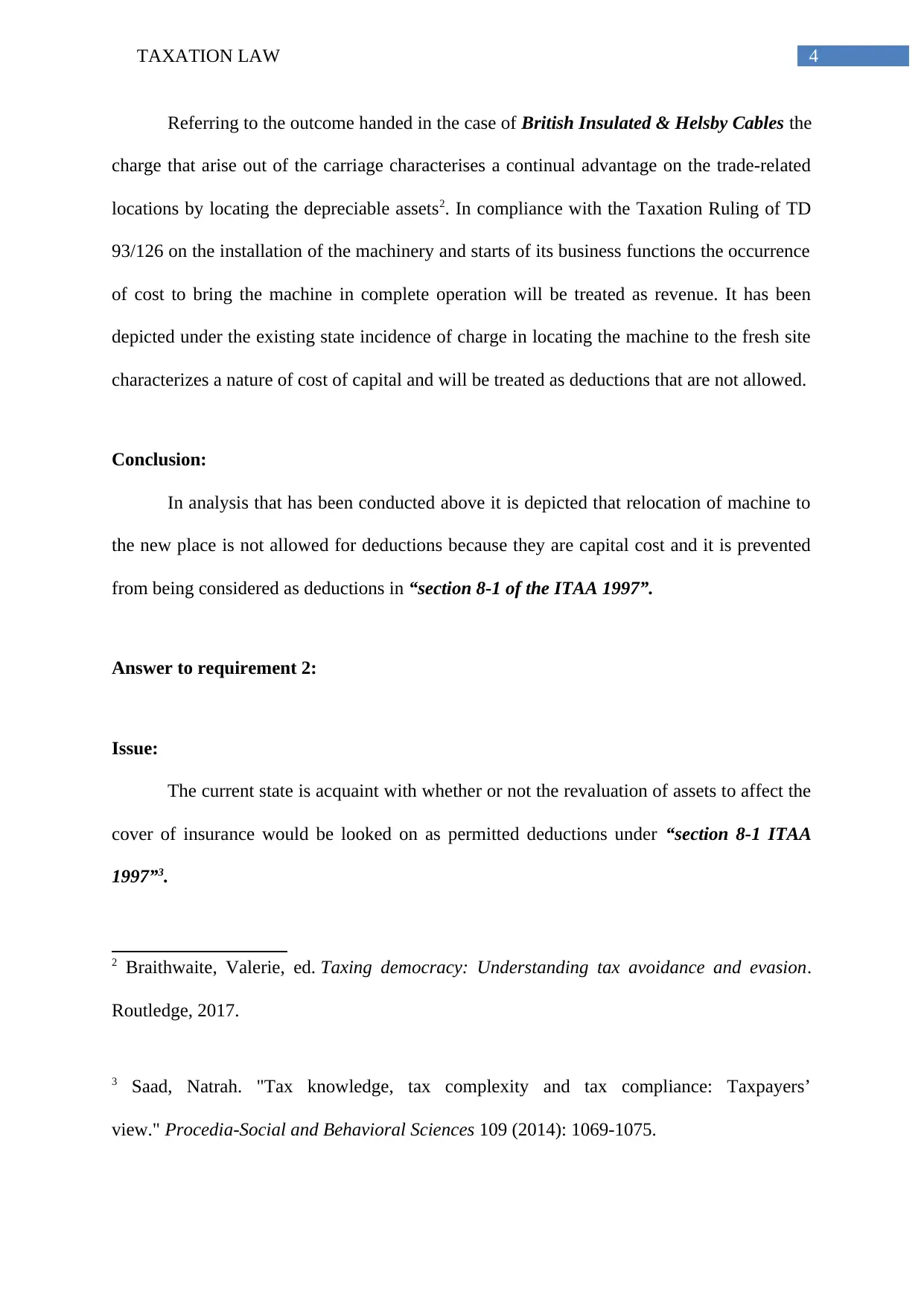
4TAXATION LAW
Referring to the outcome handed in the case of British Insulated & Helsby Cables the
charge that arise out of the carriage characterises a continual advantage on the trade-related
locations by locating the depreciable assets2. In compliance with the Taxation Ruling of TD
93/126 on the installation of the machinery and starts of its business functions the occurrence
of cost to bring the machine in complete operation will be treated as revenue. It has been
depicted under the existing state incidence of charge in locating the machine to the fresh site
characterizes a nature of cost of capital and will be treated as deductions that are not allowed.
Conclusion:
In analysis that has been conducted above it is depicted that relocation of machine to
the new place is not allowed for deductions because they are capital cost and it is prevented
from being considered as deductions in “section 8-1 of the ITAA 1997”.
Answer to requirement 2:
Issue:
The current state is acquaint with whether or not the revaluation of assets to affect the
cover of insurance would be looked on as permitted deductions under “section 8-1 ITAA
1997”3.
2 Braithwaite, Valerie, ed. Taxing democracy: Understanding tax avoidance and evasion.
Routledge, 2017.
3 Saad, Natrah. "Tax knowledge, tax complexity and tax compliance: Taxpayers’
view." Procedia-Social and Behavioral Sciences 109 (2014): 1069-1075.
Referring to the outcome handed in the case of British Insulated & Helsby Cables the
charge that arise out of the carriage characterises a continual advantage on the trade-related
locations by locating the depreciable assets2. In compliance with the Taxation Ruling of TD
93/126 on the installation of the machinery and starts of its business functions the occurrence
of cost to bring the machine in complete operation will be treated as revenue. It has been
depicted under the existing state incidence of charge in locating the machine to the fresh site
characterizes a nature of cost of capital and will be treated as deductions that are not allowed.
Conclusion:
In analysis that has been conducted above it is depicted that relocation of machine to
the new place is not allowed for deductions because they are capital cost and it is prevented
from being considered as deductions in “section 8-1 of the ITAA 1997”.
Answer to requirement 2:
Issue:
The current state is acquaint with whether or not the revaluation of assets to affect the
cover of insurance would be looked on as permitted deductions under “section 8-1 ITAA
1997”3.
2 Braithwaite, Valerie, ed. Taxing democracy: Understanding tax avoidance and evasion.
Routledge, 2017.
3 Saad, Natrah. "Tax knowledge, tax complexity and tax compliance: Taxpayers’
view." Procedia-Social and Behavioral Sciences 109 (2014): 1069-1075.
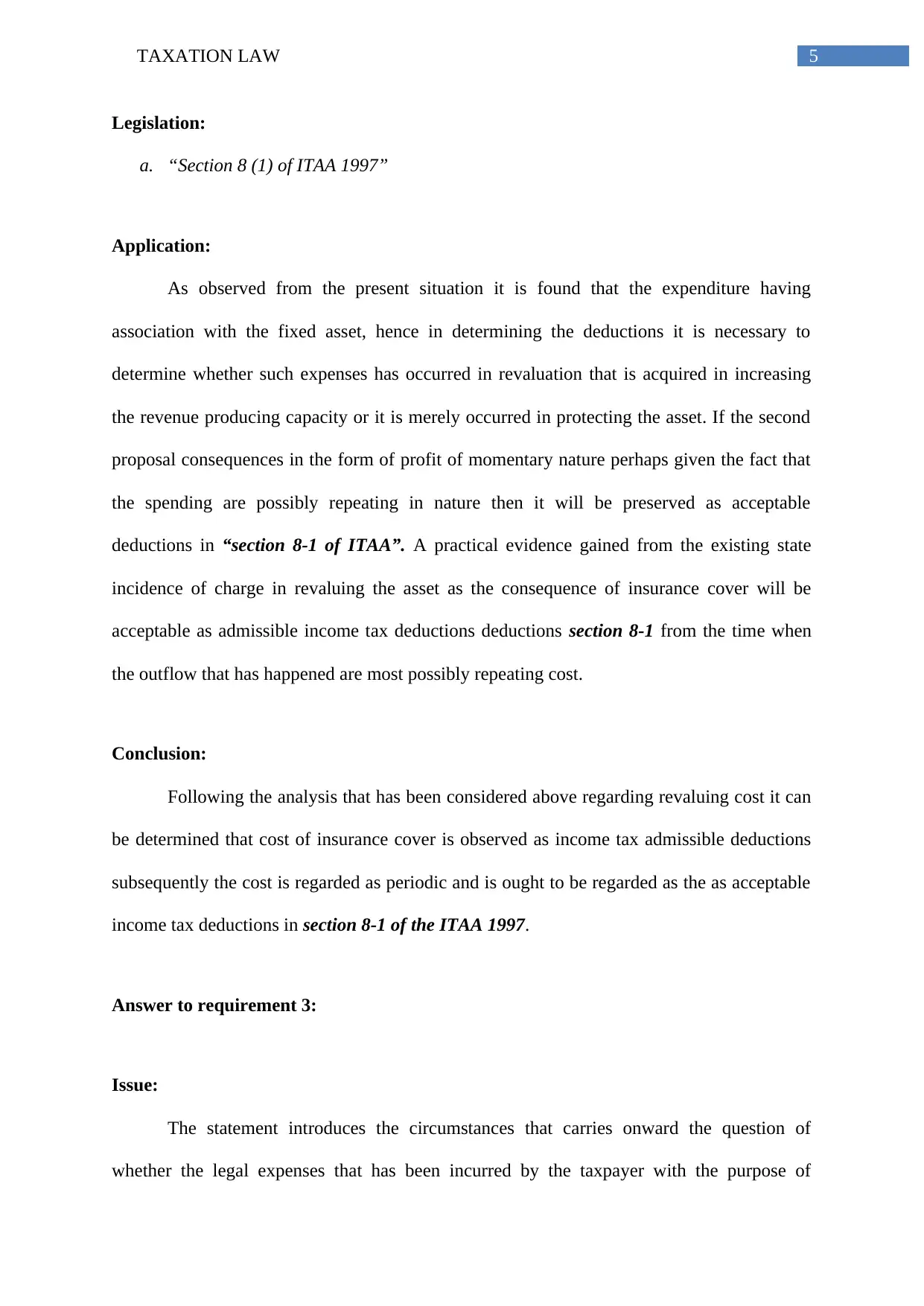
5TAXATION LAW
Legislation:
a. “Section 8 (1) of ITAA 1997”
Application:
As observed from the present situation it is found that the expenditure having
association with the fixed asset, hence in determining the deductions it is necessary to
determine whether such expenses has occurred in revaluation that is acquired in increasing
the revenue producing capacity or it is merely occurred in protecting the asset. If the second
proposal consequences in the form of profit of momentary nature perhaps given the fact that
the spending are possibly repeating in nature then it will be preserved as acceptable
deductions in “section 8-1 of ITAA”. A practical evidence gained from the existing state
incidence of charge in revaluing the asset as the consequence of insurance cover will be
acceptable as admissible income tax deductions deductions section 8-1 from the time when
the outflow that has happened are most possibly repeating cost.
Conclusion:
Following the analysis that has been considered above regarding revaluing cost it can
be determined that cost of insurance cover is observed as income tax admissible deductions
subsequently the cost is regarded as periodic and is ought to be regarded as the as acceptable
income tax deductions in section 8-1 of the ITAA 1997.
Answer to requirement 3:
Issue:
The statement introduces the circumstances that carries onward the question of
whether the legal expenses that has been incurred by the taxpayer with the purpose of
Legislation:
a. “Section 8 (1) of ITAA 1997”
Application:
As observed from the present situation it is found that the expenditure having
association with the fixed asset, hence in determining the deductions it is necessary to
determine whether such expenses has occurred in revaluation that is acquired in increasing
the revenue producing capacity or it is merely occurred in protecting the asset. If the second
proposal consequences in the form of profit of momentary nature perhaps given the fact that
the spending are possibly repeating in nature then it will be preserved as acceptable
deductions in “section 8-1 of ITAA”. A practical evidence gained from the existing state
incidence of charge in revaluing the asset as the consequence of insurance cover will be
acceptable as admissible income tax deductions deductions section 8-1 from the time when
the outflow that has happened are most possibly repeating cost.
Conclusion:
Following the analysis that has been considered above regarding revaluing cost it can
be determined that cost of insurance cover is observed as income tax admissible deductions
subsequently the cost is regarded as periodic and is ought to be regarded as the as acceptable
income tax deductions in section 8-1 of the ITAA 1997.
Answer to requirement 3:
Issue:
The statement introduces the circumstances that carries onward the question of
whether the legal expenses that has been incurred by the taxpayer with the purpose of
⊘ This is a preview!⊘
Do you want full access?
Subscribe today to unlock all pages.

Trusted by 1+ million students worldwide
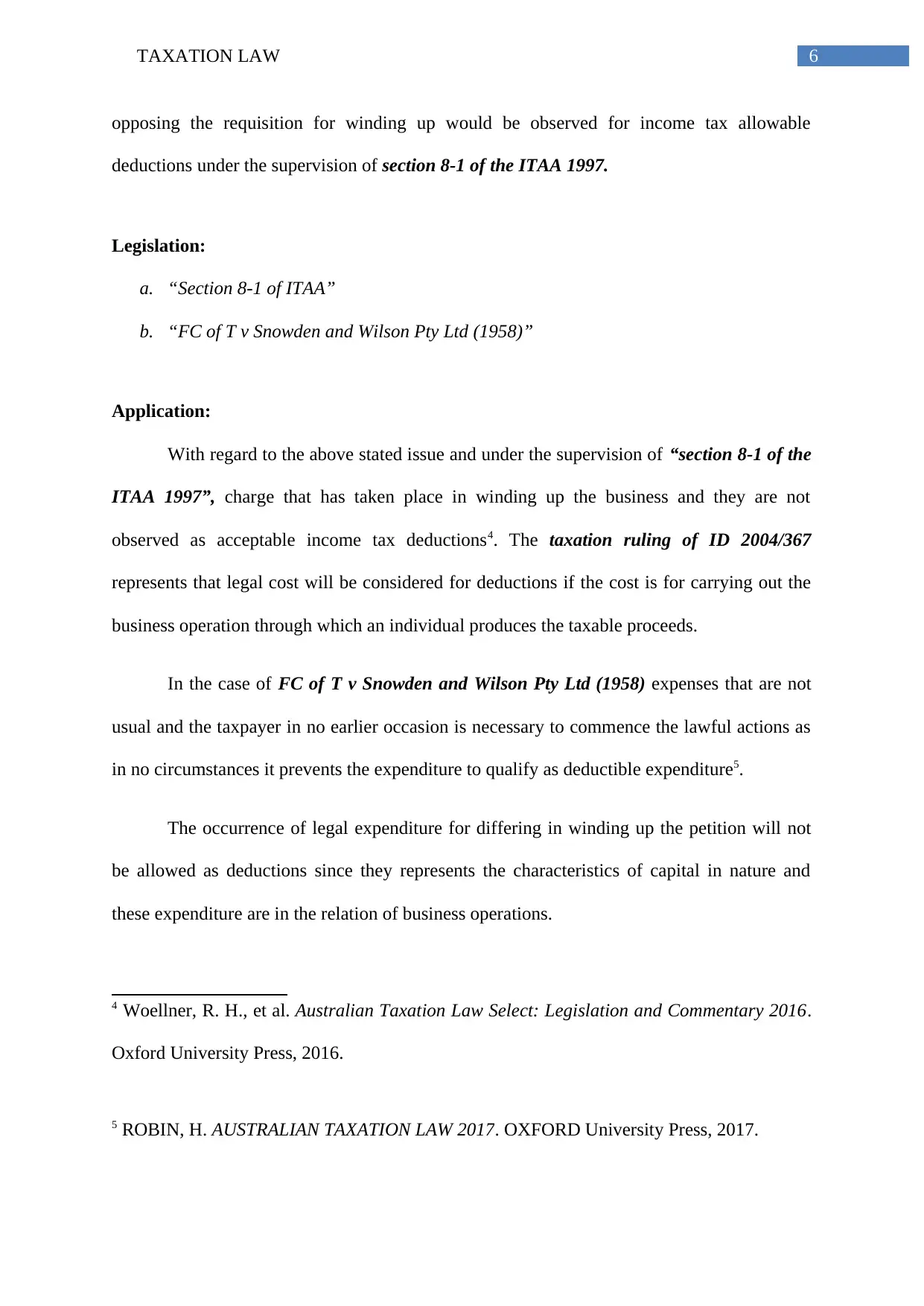
6TAXATION LAW
opposing the requisition for winding up would be observed for income tax allowable
deductions under the supervision of section 8-1 of the ITAA 1997.
Legislation:
a. “Section 8-1 of ITAA”
b. “FC of T v Snowden and Wilson Pty Ltd (1958)”
Application:
With regard to the above stated issue and under the supervision of “section 8-1 of the
ITAA 1997”, charge that has taken place in winding up the business and they are not
observed as acceptable income tax deductions4. The taxation ruling of ID 2004/367
represents that legal cost will be considered for deductions if the cost is for carrying out the
business operation through which an individual produces the taxable proceeds.
In the case of FC of T v Snowden and Wilson Pty Ltd (1958) expenses that are not
usual and the taxpayer in no earlier occasion is necessary to commence the lawful actions as
in no circumstances it prevents the expenditure to qualify as deductible expenditure5.
The occurrence of legal expenditure for differing in winding up the petition will not
be allowed as deductions since they represents the characteristics of capital in nature and
these expenditure are in the relation of business operations.
4 Woellner, R. H., et al. Australian Taxation Law Select: Legislation and Commentary 2016.
Oxford University Press, 2016.
5 ROBIN, H. AUSTRALIAN TAXATION LAW 2017. OXFORD University Press, 2017.
opposing the requisition for winding up would be observed for income tax allowable
deductions under the supervision of section 8-1 of the ITAA 1997.
Legislation:
a. “Section 8-1 of ITAA”
b. “FC of T v Snowden and Wilson Pty Ltd (1958)”
Application:
With regard to the above stated issue and under the supervision of “section 8-1 of the
ITAA 1997”, charge that has taken place in winding up the business and they are not
observed as acceptable income tax deductions4. The taxation ruling of ID 2004/367
represents that legal cost will be considered for deductions if the cost is for carrying out the
business operation through which an individual produces the taxable proceeds.
In the case of FC of T v Snowden and Wilson Pty Ltd (1958) expenses that are not
usual and the taxpayer in no earlier occasion is necessary to commence the lawful actions as
in no circumstances it prevents the expenditure to qualify as deductible expenditure5.
The occurrence of legal expenditure for differing in winding up the petition will not
be allowed as deductions since they represents the characteristics of capital in nature and
these expenditure are in the relation of business operations.
4 Woellner, R. H., et al. Australian Taxation Law Select: Legislation and Commentary 2016.
Oxford University Press, 2016.
5 ROBIN, H. AUSTRALIAN TAXATION LAW 2017. OXFORD University Press, 2017.
Paraphrase This Document
Need a fresh take? Get an instant paraphrase of this document with our AI Paraphraser
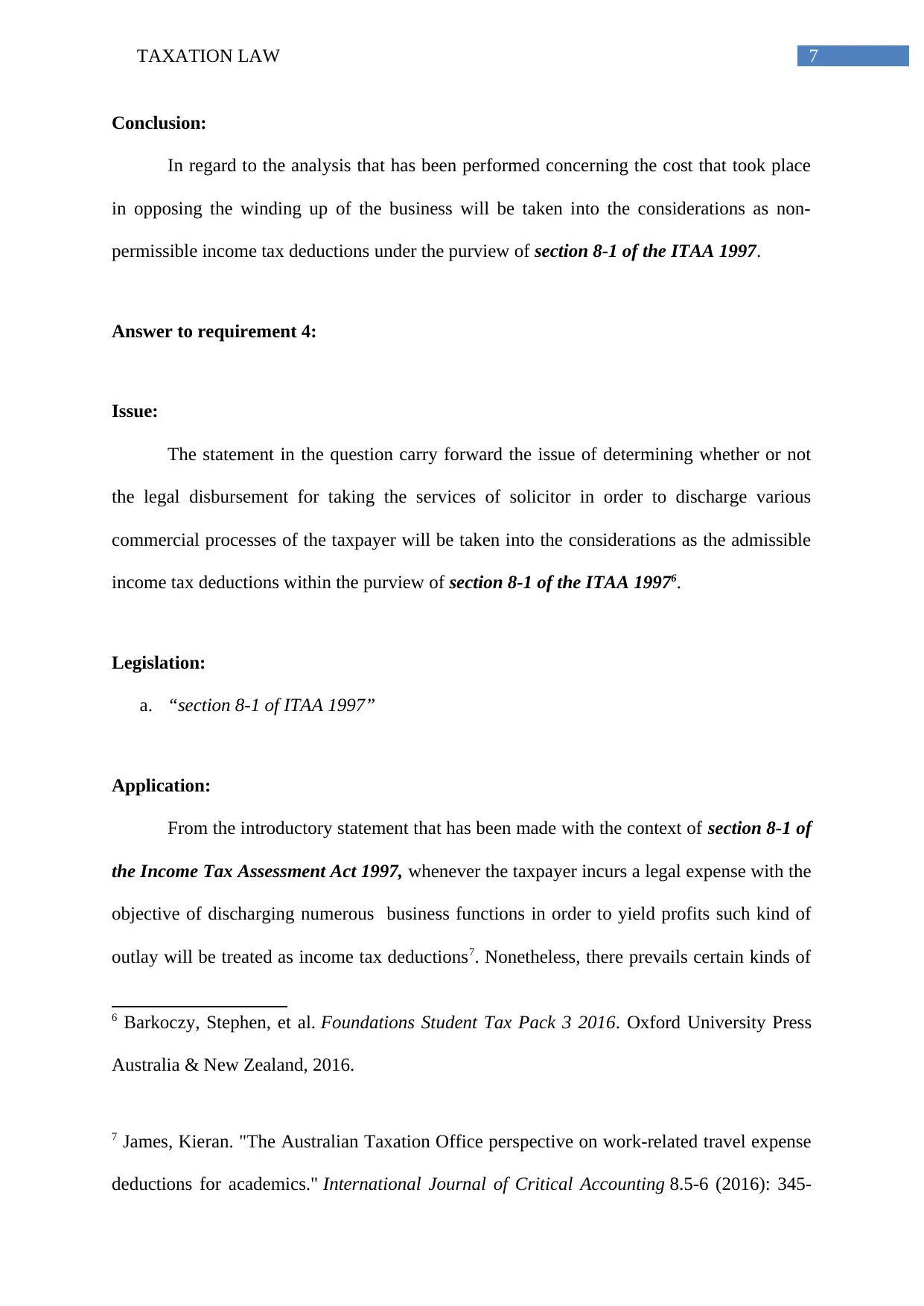
7TAXATION LAW
Conclusion:
In regard to the analysis that has been performed concerning the cost that took place
in opposing the winding up of the business will be taken into the considerations as non-
permissible income tax deductions under the purview of section 8-1 of the ITAA 1997.
Answer to requirement 4:
Issue:
The statement in the question carry forward the issue of determining whether or not
the legal disbursement for taking the services of solicitor in order to discharge various
commercial processes of the taxpayer will be taken into the considerations as the admissible
income tax deductions within the purview of section 8-1 of the ITAA 19976.
Legislation:
a. “section 8-1 of ITAA 1997”
Application:
From the introductory statement that has been made with the context of section 8-1 of
the Income Tax Assessment Act 1997, whenever the taxpayer incurs a legal expense with the
objective of discharging numerous business functions in order to yield profits such kind of
outlay will be treated as income tax deductions7. Nonetheless, there prevails certain kinds of
6 Barkoczy, Stephen, et al. Foundations Student Tax Pack 3 2016. Oxford University Press
Australia & New Zealand, 2016.
7 James, Kieran. "The Australian Taxation Office perspective on work-related travel expense
deductions for academics." International Journal of Critical Accounting 8.5-6 (2016): 345-
Conclusion:
In regard to the analysis that has been performed concerning the cost that took place
in opposing the winding up of the business will be taken into the considerations as non-
permissible income tax deductions under the purview of section 8-1 of the ITAA 1997.
Answer to requirement 4:
Issue:
The statement in the question carry forward the issue of determining whether or not
the legal disbursement for taking the services of solicitor in order to discharge various
commercial processes of the taxpayer will be taken into the considerations as the admissible
income tax deductions within the purview of section 8-1 of the ITAA 19976.
Legislation:
a. “section 8-1 of ITAA 1997”
Application:
From the introductory statement that has been made with the context of section 8-1 of
the Income Tax Assessment Act 1997, whenever the taxpayer incurs a legal expense with the
objective of discharging numerous business functions in order to yield profits such kind of
outlay will be treated as income tax deductions7. Nonetheless, there prevails certain kinds of
6 Barkoczy, Stephen, et al. Foundations Student Tax Pack 3 2016. Oxford University Press
Australia & New Zealand, 2016.
7 James, Kieran. "The Australian Taxation Office perspective on work-related travel expense
deductions for academics." International Journal of Critical Accounting 8.5-6 (2016): 345-
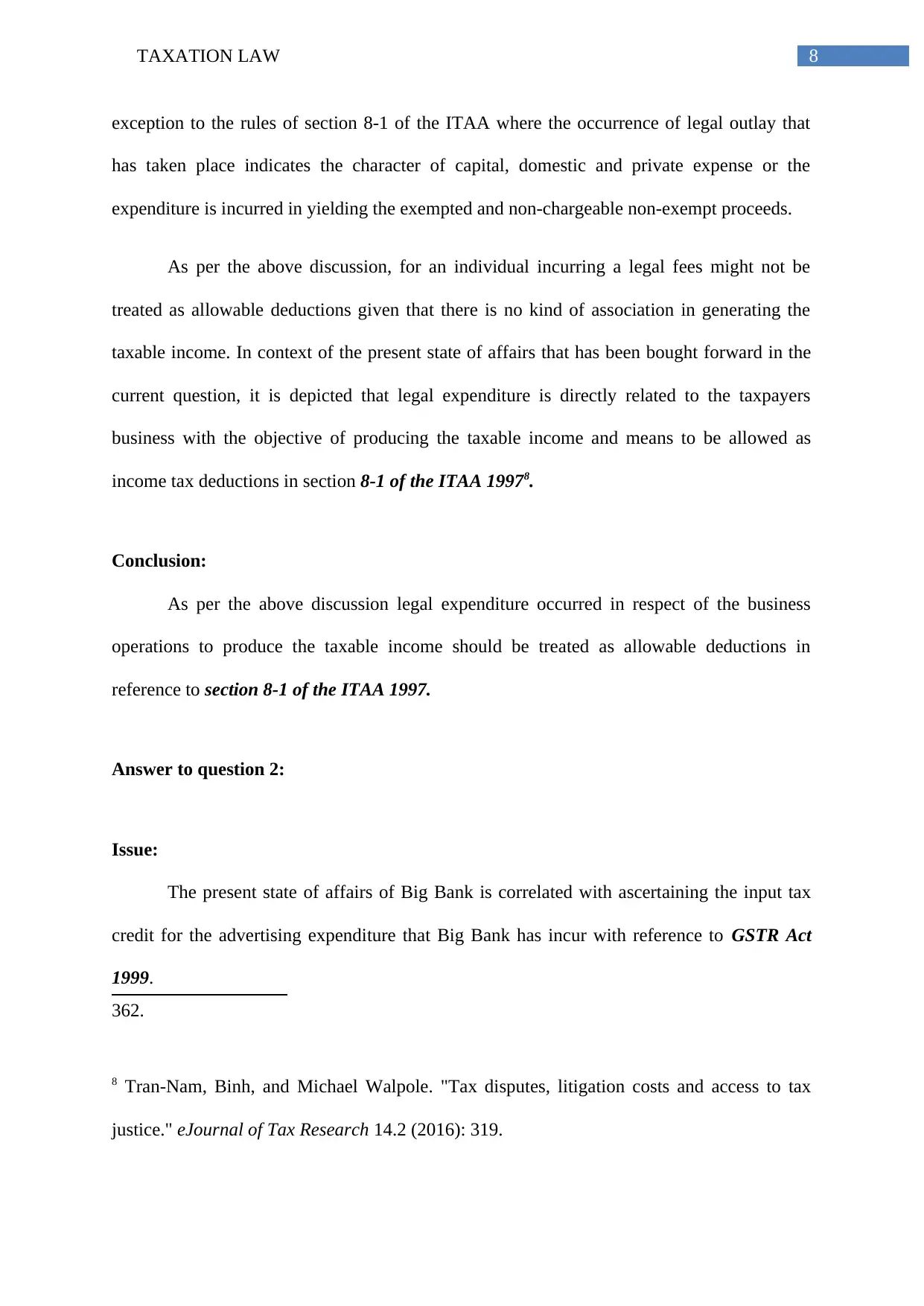
8TAXATION LAW
exception to the rules of section 8-1 of the ITAA where the occurrence of legal outlay that
has taken place indicates the character of capital, domestic and private expense or the
expenditure is incurred in yielding the exempted and non-chargeable non-exempt proceeds.
As per the above discussion, for an individual incurring a legal fees might not be
treated as allowable deductions given that there is no kind of association in generating the
taxable income. In context of the present state of affairs that has been bought forward in the
current question, it is depicted that legal expenditure is directly related to the taxpayers
business with the objective of producing the taxable income and means to be allowed as
income tax deductions in section 8-1 of the ITAA 19978.
Conclusion:
As per the above discussion legal expenditure occurred in respect of the business
operations to produce the taxable income should be treated as allowable deductions in
reference to section 8-1 of the ITAA 1997.
Answer to question 2:
Issue:
The present state of affairs of Big Bank is correlated with ascertaining the input tax
credit for the advertising expenditure that Big Bank has incur with reference to GSTR Act
1999.
362.
8 Tran-Nam, Binh, and Michael Walpole. "Tax disputes, litigation costs and access to tax
justice." eJournal of Tax Research 14.2 (2016): 319.
exception to the rules of section 8-1 of the ITAA where the occurrence of legal outlay that
has taken place indicates the character of capital, domestic and private expense or the
expenditure is incurred in yielding the exempted and non-chargeable non-exempt proceeds.
As per the above discussion, for an individual incurring a legal fees might not be
treated as allowable deductions given that there is no kind of association in generating the
taxable income. In context of the present state of affairs that has been bought forward in the
current question, it is depicted that legal expenditure is directly related to the taxpayers
business with the objective of producing the taxable income and means to be allowed as
income tax deductions in section 8-1 of the ITAA 19978.
Conclusion:
As per the above discussion legal expenditure occurred in respect of the business
operations to produce the taxable income should be treated as allowable deductions in
reference to section 8-1 of the ITAA 1997.
Answer to question 2:
Issue:
The present state of affairs of Big Bank is correlated with ascertaining the input tax
credit for the advertising expenditure that Big Bank has incur with reference to GSTR Act
1999.
362.
8 Tran-Nam, Binh, and Michael Walpole. "Tax disputes, litigation costs and access to tax
justice." eJournal of Tax Research 14.2 (2016): 319.
⊘ This is a preview!⊘
Do you want full access?
Subscribe today to unlock all pages.

Trusted by 1+ million students worldwide
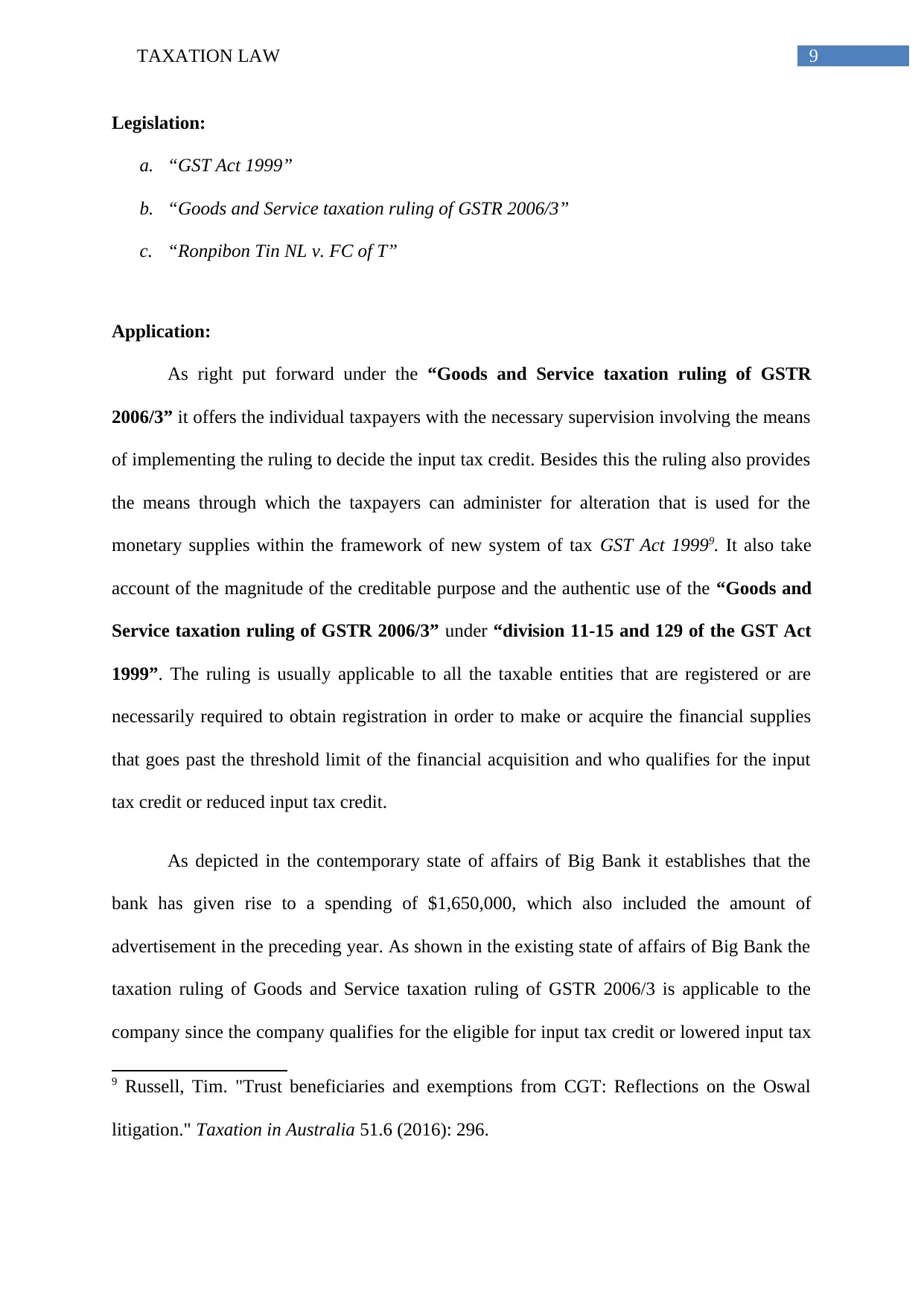
9TAXATION LAW
Legislation:
a. “GST Act 1999”
b. “Goods and Service taxation ruling of GSTR 2006/3”
c. “Ronpibon Tin NL v. FC of T”
Application:
As right put forward under the “Goods and Service taxation ruling of GSTR
2006/3” it offers the individual taxpayers with the necessary supervision involving the means
of implementing the ruling to decide the input tax credit. Besides this the ruling also provides
the means through which the taxpayers can administer for alteration that is used for the
monetary supplies within the framework of new system of tax GST Act 19999. It also take
account of the magnitude of the creditable purpose and the authentic use of the “Goods and
Service taxation ruling of GSTR 2006/3” under “division 11-15 and 129 of the GST Act
1999”. The ruling is usually applicable to all the taxable entities that are registered or are
necessarily required to obtain registration in order to make or acquire the financial supplies
that goes past the threshold limit of the financial acquisition and who qualifies for the input
tax credit or reduced input tax credit.
As depicted in the contemporary state of affairs of Big Bank it establishes that the
bank has given rise to a spending of $1,650,000, which also included the amount of
advertisement in the preceding year. As shown in the existing state of affairs of Big Bank the
taxation ruling of Goods and Service taxation ruling of GSTR 2006/3 is applicable to the
company since the company qualifies for the eligible for input tax credit or lowered input tax
9 Russell, Tim. "Trust beneficiaries and exemptions from CGT: Reflections on the Oswal
litigation." Taxation in Australia 51.6 (2016): 296.
Legislation:
a. “GST Act 1999”
b. “Goods and Service taxation ruling of GSTR 2006/3”
c. “Ronpibon Tin NL v. FC of T”
Application:
As right put forward under the “Goods and Service taxation ruling of GSTR
2006/3” it offers the individual taxpayers with the necessary supervision involving the means
of implementing the ruling to decide the input tax credit. Besides this the ruling also provides
the means through which the taxpayers can administer for alteration that is used for the
monetary supplies within the framework of new system of tax GST Act 19999. It also take
account of the magnitude of the creditable purpose and the authentic use of the “Goods and
Service taxation ruling of GSTR 2006/3” under “division 11-15 and 129 of the GST Act
1999”. The ruling is usually applicable to all the taxable entities that are registered or are
necessarily required to obtain registration in order to make or acquire the financial supplies
that goes past the threshold limit of the financial acquisition and who qualifies for the input
tax credit or reduced input tax credit.
As depicted in the contemporary state of affairs of Big Bank it establishes that the
bank has given rise to a spending of $1,650,000, which also included the amount of
advertisement in the preceding year. As shown in the existing state of affairs of Big Bank the
taxation ruling of Goods and Service taxation ruling of GSTR 2006/3 is applicable to the
company since the company qualifies for the eligible for input tax credit or lowered input tax
9 Russell, Tim. "Trust beneficiaries and exemptions from CGT: Reflections on the Oswal
litigation." Taxation in Australia 51.6 (2016): 296.
Paraphrase This Document
Need a fresh take? Get an instant paraphrase of this document with our AI Paraphraser
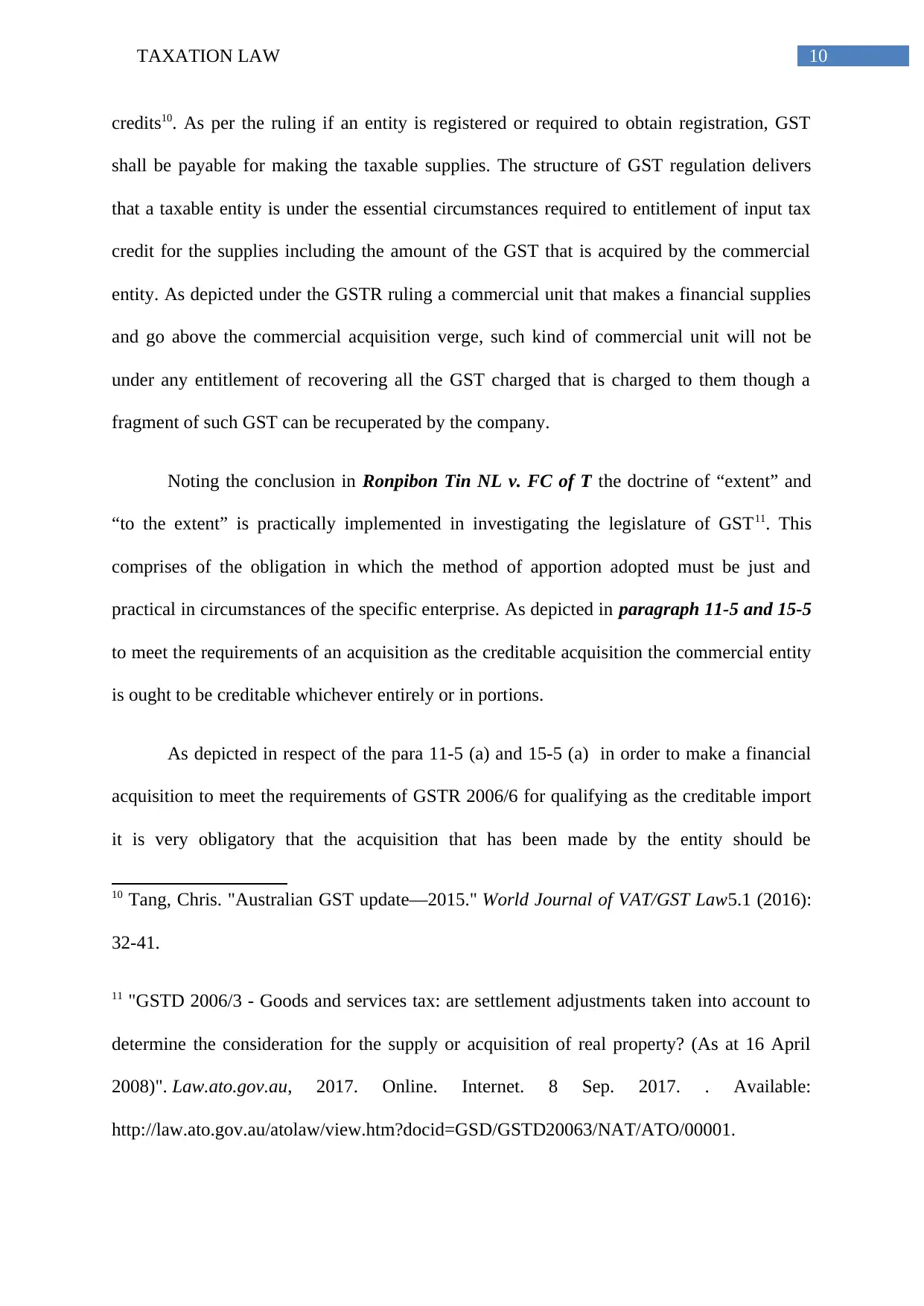
10TAXATION LAW
credits10. As per the ruling if an entity is registered or required to obtain registration, GST
shall be payable for making the taxable supplies. The structure of GST regulation delivers
that a taxable entity is under the essential circumstances required to entitlement of input tax
credit for the supplies including the amount of the GST that is acquired by the commercial
entity. As depicted under the GSTR ruling a commercial unit that makes a financial supplies
and go above the commercial acquisition verge, such kind of commercial unit will not be
under any entitlement of recovering all the GST charged that is charged to them though a
fragment of such GST can be recuperated by the company.
Noting the conclusion in Ronpibon Tin NL v. FC of T the doctrine of “extent” and
“to the extent” is practically implemented in investigating the legislature of GST11. This
comprises of the obligation in which the method of apportion adopted must be just and
practical in circumstances of the specific enterprise. As depicted in paragraph 11-5 and 15-5
to meet the requirements of an acquisition as the creditable acquisition the commercial entity
is ought to be creditable whichever entirely or in portions.
As depicted in respect of the para 11-5 (a) and 15-5 (a) in order to make a financial
acquisition to meet the requirements of GSTR 2006/6 for qualifying as the creditable import
it is very obligatory that the acquisition that has been made by the entity should be
10 Tang, Chris. "Australian GST update—2015." World Journal of VAT/GST Law5.1 (2016):
32-41.
11 "GSTD 2006/3 - Goods and services tax: are settlement adjustments taken into account to
determine the consideration for the supply or acquisition of real property? (As at 16 April
2008)". Law.ato.gov.au, 2017. Online. Internet. 8 Sep. 2017. . Available:
http://law.ato.gov.au/atolaw/view.htm?docid=GSD/GSTD20063/NAT/ATO/00001.
credits10. As per the ruling if an entity is registered or required to obtain registration, GST
shall be payable for making the taxable supplies. The structure of GST regulation delivers
that a taxable entity is under the essential circumstances required to entitlement of input tax
credit for the supplies including the amount of the GST that is acquired by the commercial
entity. As depicted under the GSTR ruling a commercial unit that makes a financial supplies
and go above the commercial acquisition verge, such kind of commercial unit will not be
under any entitlement of recovering all the GST charged that is charged to them though a
fragment of such GST can be recuperated by the company.
Noting the conclusion in Ronpibon Tin NL v. FC of T the doctrine of “extent” and
“to the extent” is practically implemented in investigating the legislature of GST11. This
comprises of the obligation in which the method of apportion adopted must be just and
practical in circumstances of the specific enterprise. As depicted in paragraph 11-5 and 15-5
to meet the requirements of an acquisition as the creditable acquisition the commercial entity
is ought to be creditable whichever entirely or in portions.
As depicted in respect of the para 11-5 (a) and 15-5 (a) in order to make a financial
acquisition to meet the requirements of GSTR 2006/6 for qualifying as the creditable import
it is very obligatory that the acquisition that has been made by the entity should be
10 Tang, Chris. "Australian GST update—2015." World Journal of VAT/GST Law5.1 (2016):
32-41.
11 "GSTD 2006/3 - Goods and services tax: are settlement adjustments taken into account to
determine the consideration for the supply or acquisition of real property? (As at 16 April
2008)". Law.ato.gov.au, 2017. Online. Internet. 8 Sep. 2017. . Available:
http://law.ato.gov.au/atolaw/view.htm?docid=GSD/GSTD20063/NAT/ATO/00001.
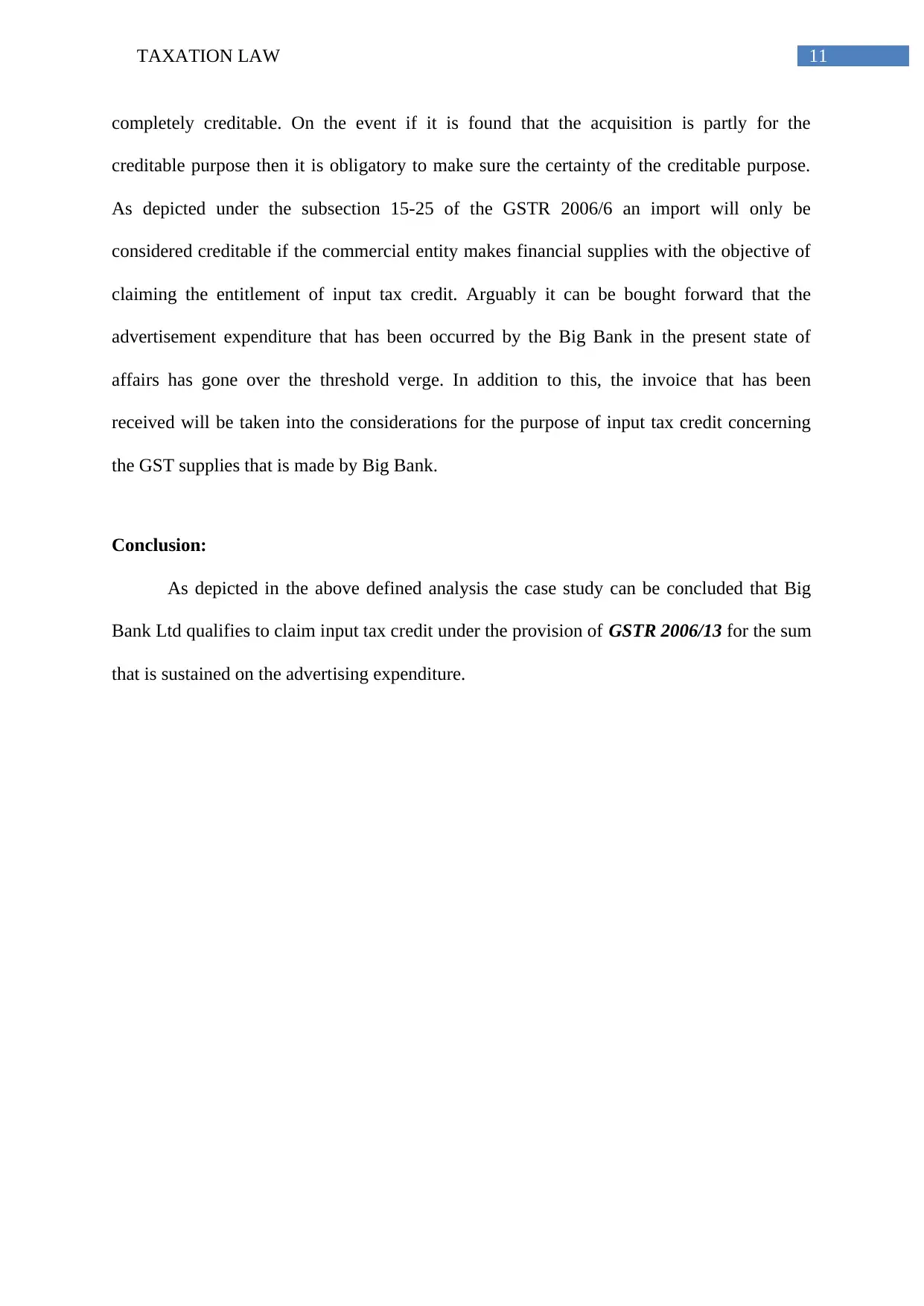
11TAXATION LAW
completely creditable. On the event if it is found that the acquisition is partly for the
creditable purpose then it is obligatory to make sure the certainty of the creditable purpose.
As depicted under the subsection 15-25 of the GSTR 2006/6 an import will only be
considered creditable if the commercial entity makes financial supplies with the objective of
claiming the entitlement of input tax credit. Arguably it can be bought forward that the
advertisement expenditure that has been occurred by the Big Bank in the present state of
affairs has gone over the threshold verge. In addition to this, the invoice that has been
received will be taken into the considerations for the purpose of input tax credit concerning
the GST supplies that is made by Big Bank.
Conclusion:
As depicted in the above defined analysis the case study can be concluded that Big
Bank Ltd qualifies to claim input tax credit under the provision of GSTR 2006/13 for the sum
that is sustained on the advertising expenditure.
completely creditable. On the event if it is found that the acquisition is partly for the
creditable purpose then it is obligatory to make sure the certainty of the creditable purpose.
As depicted under the subsection 15-25 of the GSTR 2006/6 an import will only be
considered creditable if the commercial entity makes financial supplies with the objective of
claiming the entitlement of input tax credit. Arguably it can be bought forward that the
advertisement expenditure that has been occurred by the Big Bank in the present state of
affairs has gone over the threshold verge. In addition to this, the invoice that has been
received will be taken into the considerations for the purpose of input tax credit concerning
the GST supplies that is made by Big Bank.
Conclusion:
As depicted in the above defined analysis the case study can be concluded that Big
Bank Ltd qualifies to claim input tax credit under the provision of GSTR 2006/13 for the sum
that is sustained on the advertising expenditure.
⊘ This is a preview!⊘
Do you want full access?
Subscribe today to unlock all pages.

Trusted by 1+ million students worldwide
1 out of 18
Related Documents
Your All-in-One AI-Powered Toolkit for Academic Success.
+13062052269
info@desklib.com
Available 24*7 on WhatsApp / Email
![[object Object]](/_next/static/media/star-bottom.7253800d.svg)
Unlock your academic potential
Copyright © 2020–2025 A2Z Services. All Rights Reserved. Developed and managed by ZUCOL.





